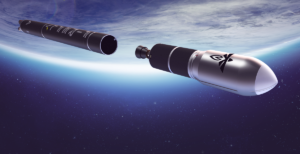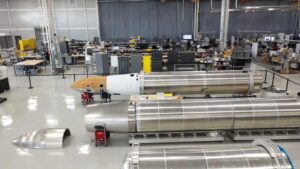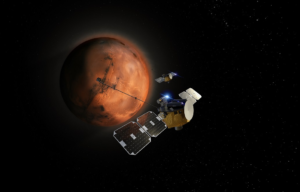
A Closer Look At SpinLaunch’s Plans Going Forward
We recently watched SpinLaunch’s 10th flight test using the suborbital accelerator. In addition, the company announced the test was a major success, which for the first time included a few different payloads from NASA and various companies. However, with 10 flight tests under the company’s belt, this brings up the question of what exactly is their plan, and when should we expect progress on an orbital accelerator.
While the company is very confident in this technology and the results from the suborbital accelerator, there is a big difference between this and a model capable of flinging payloads into orbit. Since SpinLaunch was created, the goal has been a much bigger and more powerful system with these exact capabilities. This being said, the company is currently working on the future launch site location, and more.
SpinLaunch has many skeptics of its unique design. This will continue to be the case until the company begins work on an official orbital accelerator and starts seeing some results. Based on the company’s timelines, this could be a lot sooner than most think. Here I will go more in-depth into some of SpinLaunch’s recent progress, plans for the near future, what to expect, and more.
Timeline & Plans

SpinLaunch was founded back in 2014 by Jonathan Yaney. Not long after they started development in early 2015. Less than two years later, SpinLaunch surpassed the record for the fastest rotational tip speeds and subsequently conducted hundreds of launches in its headquarters based laboratory. For years it worked to develop and create the first suborbital accelerator. The Suborbital Accelerator is designed to operate from 800 to 5,000 mph and acts primarily as a test-bed for the Orbital Launch System. Just around one year ago, on October 22nd, 2021, the company’s first launch successfully propelled a test vehicle at supersonic speeds and ended with the recovery of the reusable flight vehicle.
Throughout 2022 the system has conducted regular test flights with a variety of vehicles and launch velocities. Specifically, the company’s first 10 test flights reached as much as 30,000 feet (9,100 m) in altitude. With this in mind, we can compare the current test numbers to what’s expected out of the future orbital variant. In this case, the technology uses a vacuum-sealed centrifuge to spin a rocket and then hurl it into space at up to 4,660 mph. The rocket then ignites its engines at an altitude of roughly 200,000 ft (60 km) to reach an orbital speed of around 17,000 mph with a payload of up to 200kg. It’s estimated that peak acceleration would be approximately 10,000 g. This is an important number when we take a closer look at the recent test flight. As part of the pre-flight qualification process, SpinLaunch accelerated payloads up to 10,000G in SpinLaunch’s 12-meter Lab Accelerator at its Long Beach headquarters. Payloads were inspected post-spin and subsequently integrated into the Flight Test Vehicle in preparation for Flight Test 10. Other than this, SpinLaunch did not release a lot of specific information regarding this test. They did however comment that “The flight test, which occurred on September 27, 2022, demonstrated that SpinLaunch partners’ standard satellite components are inherently compatible with the company’s launch environment, and provided critical flight data, as all payloads were flown and recovered successfully.”
This being said, it looks like SpinLaunch is not far away from releasing some important information and starting on an orbital accelerator. Earlier this year, the company announced a future development in a quote saying, “The first Orbital Launch Site is in final selection in a soon-to-be-disclosed location in a coastal region of the United States. We are closely collaborating with the FAA and other governing agencies for launch site licensing.” This is very big news as an official site would mark the beginning of physical progress on an orbital accelerator rather than continued tests on the suborbital variant. Being that this was released quite a while ago, it’s very possible that within the next few months, SpinLaunch officially announces the future location of its ambitious operations. This also has to do with the company’s main goal of having an operational orbital accelerator by 2025. With it already being late 2022, construction would likely need to begin sometime soon if they want to achieve such an aggressive timeline. Something we will have to keep an eye out for as they progress.
Orbital Accelerator

Now that we know more about the suborbital accelerator, its overall test results, and a rough idea of the company’s future schedule, we can take a closer look at the orbital accelerator. SpinLaunch describes the Orbital Launch System as a fundamentally new way to reach space. The velocity boost provided by the accelerator’s electric drive results in a 4x reduction in the fuel required to reach orbit, a 10x reduction in cost, and the ability to launch multiple times per day. For reference, this orbital variant is expected to be around 3 times the size of the suborbital accelerator. While the suborbital version has sent payloads close to 30,000ft throughout its various test flight, the orbital version is aiming for around 200,000ft.
SpinLaunch highlights that with industry plans to launch ten times the number of satellites over the next decade, it is more urgent than ever to develop environmentally sustainable space access technology. Because kinetically launched satellites exit the stratosphere without a rocket, SpinLaunch is trying to enable a future in which constellations of satellites and space payloads can be launched with zero emissions in the most critical layers of the atmosphere. In a future where large numbers of people are traveling to space — structures, equipment, and supplies required to support in-space civilization must also be launched. For tens of thousands of people to someday work and live in space, millions of tons of infrastructure and supplies must be launched. SpinLaunch is confident they could fill that exact role perfectly.
One of the most common topics and concerns brought up has to do with the forces applied to the payloads in this process. As such, an in-depth evaluation into existing industry examples of high-g capable sensors and systems was undertaken. Early research identified promising examples of complex high-g systems in the industry including artillery launched drones with deployable wings, propulsion, and optics. Following the completion of the 12 m prototype, a system capable of testing to over 20,000G’s, SpinLaunch’s engineering team began evaluating a variety of hardware packages at the 10,000G that components endure during the launch. Through this testing, they have been able to demonstrate the impressive ability of satellite systems to readily handle the centripetal environment.
One of the main ways SpinLaunch works to protect and secure the payload has to do with the rocket construction. They point out that modern carbon fiber and miniature electronics are the most relevant reasons why SpinLaunch has not been possible until recently. Carbon Fiber emerged as a high-strength composite in the early 1960s and only recently transitioned from limited aerospace applications to widespread industrial usage. Low-cost high strength to weight materials like modern carbon fiber are a critical part of what makes SpinLaunch possible while modern electronics, materials, and simulation tools allow for satellites to be adapted to the kinetic launch environment with relative ease.
Focusing back on SpinLaunch’s comment about announcing a coastal launch site in the near future, there are a few different things to consider. For one they said it will be in the United States. In addition, there are factors like the sonic boom it will create. In regards to this, the company has mentioned that it does not have a higher sonic impact than a traditional rocket lifting off. During the launch, a short duration sonic boom is projected outwards and upwards along the trajectory of the launch vehicle. SpinLaunch uses industry standard methodologies to evaluate and comply with the Federal Aviation Administration’s requirements for noise profile analysis the same as traditional rocket launches. No doubt a factor currently being considered as they pick the future site location.
Lastly, in terms of feasibility, SpinLaunch highlights that in the 1960s, the High Altitude Research Project demonstrated that large complex launch vehicles could traverse from vacuum to atmosphere at speeds of Mach 6. While the vehicle isn’t damaged by entering the atmosphere, they have designed it to survive the temporary high temperatures generated as it exits the atmosphere. The tip of the launch vehicle acts as a heat sink, absorbing any aerothermal loads experienced during flight. The heating load is less than that of other industry examples of high-speed flight. All of which will determine the future outcome and location as SpinLaunch attempts to take a leap in progress.
Conclusion
SpinLaunch recently completed its 10th test flight using its suborbital accelerator. In addition, not long from now, we should expect a big announcement about the future coastal site where the company will build the first orbital accelerator. A necessary step toward the ambitious goal of orbital launches by 2025. We will have to wait and see how it progresses and the impact it has on the space industry.



